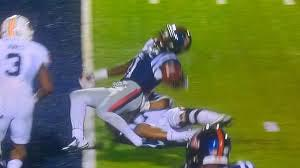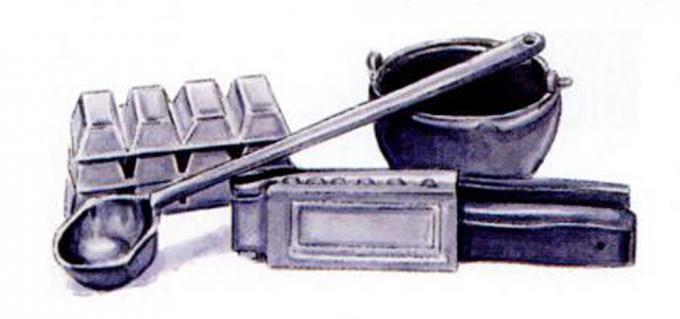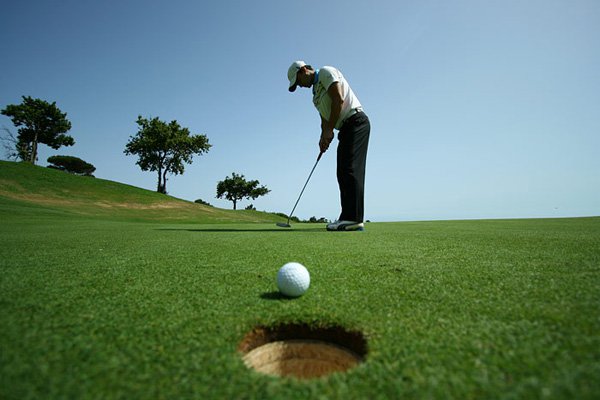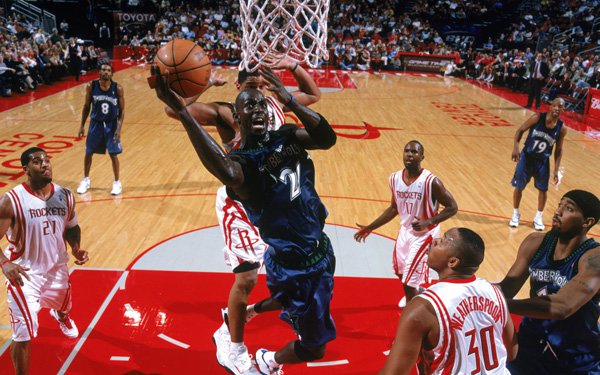QuestionQUESTION: Why was the Ole Miss wr. not down by contact when his ankle hit the ground before he crossed the goal?
 Ankle touching ground
Ankle touching ground
ANSWER: Chad,
Thank you for your question. The short simple answer is the ankle is part of the foot and doesn't make a runner/ball carrier down.
I will take you through this play and explain it to you in detail.
Under NCAA rules there is no down by contact and even under NFL rules the player would not have ben considered down. The play you ask about pertains to the 11/1/14 game between Ole Miss and Auburn at 1:39 in the 4th Qtr. This play went to Replay during the injury time out. The initial ruling on the field was that the Mississippi Runner was down short of the Goal line. Replay correctly reversed the ruling on the field.
The ball had become loose before the runner was down. The fractured ankle does touch the ground but that is not enough to consider a player down and the ball dead. The ankle is part of the foot, just as the wrist is part of the hand. A runner is not considered own and the ball remains live when a runners foot (and ankle) or hand (and wrist) touch the ground. For the runner to have been down his leg or other body part, other than his ankle needed to touch the ground.
To take you though the play, It is Mississippi's ball 3rd & 3 at the 20 yard line going in with 1:39 remaining in the 4th Quarter. Mississippi trails Auburn 31-35. Mississippi QB #14 passes to Receiver #1 who catches and runs to the goal line. The Mississippi Receiver/Runner #1 is tackled legally at the goal line by Auburn #17. This is not a horse collar tackle as the hand of the Auburn defender # was not inside the collar.
Replay correctly rules the runner Mississippi #1 is not down. The runner's left ankle drags on the ground from the 1 yard line to the goal line. The runner falls back on the tackler and is still not down on the ground. Thus the play remains live. During this time the ball comes loose in the end zone. It is a live loose ball recovered by the defense- Auburn.
The play was ruled correctly by Replay - runner not down before he lost possession and before he crossed the goal line.
With technology and HD cameras there are all kinds of angles that can be seen and play back can be enhanced and slowed down to frame by frame to view these plays. The officials on the field only get one chance to see the play at full spend from their angle and make a decision. These guys do a great job. Replay is now used to determine if the ruling on the field should be confirmed as called on the field, or whether it should stand as called because there is not enough video evidence to clearly overturn without any doubt or dispute; or whether the call on the filed should be overturned and reversed to something else. In the case of the play you ask about, the Replay clearly shows the player is not down by rule. It shows the ankle is touching the ground and as the ankle is part of the foot per the approved rulings and interpretations the runner is not down so the ball remained alive. Replay shows no other body part of the runner is down until after he lost possession of the ball and was beyond the goal line.
I hope this explains to you the play and the reason the runner #1 was not down by contact.
---------- FOLLOW-UP ----------
QUESTION: During the ND/FSU game with less than 2 minutes to go on third down for FSU at the 3 yard line, QB Winston dropped back to make a handoff to a running back and the ball,quarterback, and running back were all in the endzone at the same time. On this play a holding penalty was called and declined by ND. The penalty was called against the right guard who tackled his opponent preventing his progress. My question is: With the ball and both FSU players in the endzone, why was this not considered a safety? This would have put ND down 2 instead of 4 to which they would have just needed a field goal to win. Thank you for your time.
AnswerChat
This second question pertains to another play situation involving an Offensive Holding (OH) foul. I believe you are referencing the holding (OH) that occurred by Guard #54 in the 4th QTR. with about 3:35 on the game clock. The ball was snapped at the 4 yard line 3rd & 13 for FSU. See: https://www.youtube.com/watch?v=arJQfzkS6MA
In this play offensive Right Guard FSU #54 holds at the 3 yard line [not in the send zone] . This is a take down hold. The enforcement spot is the previous spot the 4 yard line. The play ended at about the 9 or 10 yard line so the ball was never dead in the end zone and the offensive could did not occur in the the end zone, thus no safety occurred or is possible by rule.
The ball and both the QB & RB in the end zone when the OH occurs at the 3 yard line by the Rt. G is irrelevant.
The spot of the foul is what is relevant or where the ball becomes dead by rule.
Good Question, thanks for asking. Penalty enforcement can be complicated or confusing. I tried to give you the clear layman's version.



